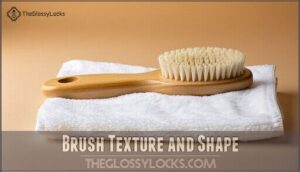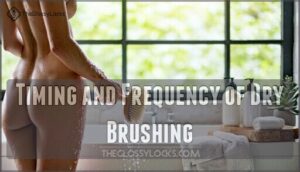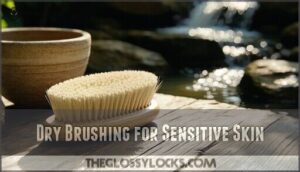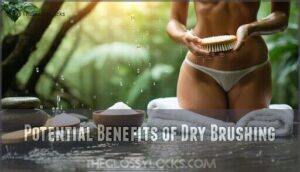This site is supported by our readers. We may earn a commission, at no cost to you, if you purchase through links.

Medical professionals consistently debunk this myth—cellulite forms deep within skin tissue where surface brushing simply can’t reach. The idea that dry brushing can fix cellulite is a myth with no basis in scientific fact, and it’s essential to understand that cellulite forms deep within the skin.
That said, dry brushing isn’t completely useless. You’ll get decent exfoliation and possibly improved circulation, making your skin feel smoother temporarily. Think of it like polishing a car—you’re enhancing the surface shine, not fixing the engine underneath.
The real cellulite-fighting arsenal involves proven treatments that actually target the structural causes.
Table Of Contents
- Key Takeaways
- The Science Behind Dry Brushing and Cellulite
- Choosing The Right Dry Brush
- Dry Brushing Technique and Routine
- Potential Benefits of Dry Brushing
- Effective Cellulite Treatments Beyond Dry Brushing
- Integrating Dry Brushing Into a Holistic Skincare Routine
- Addressing Common Concerns and Misconceptions
- The Final Takeaway: Realistic Expectations and Sustainable Practices
- Frequently Asked Questions (FAQs)
- Does dry brushing help cellulite?
- Can a body scrub cure cellulite?
- What is dry brushing your skin?
- Is there a miracle cure for cellulite?
- Can dry body brushing reduce your appearance?
- How do you clean a dry body brush?
- How many times a week should I dry brush for cellulite?
- How to dry brush cellulite on thighs?
- What are the cons of dry brushing?
- Do you dry brush up or down on legs?
- Conclusion
Key Takeaways
- You can’t brush away cellulite permanently – dry brushing only creates temporary skin plumping through increased circulation, but the dimpled appearance returns once blood flow normalizes since cellulite forms deep within connective tissue where brushes can’t reach.
- You’ll get real exfoliation and circulation benefits – while dry brushing won’t eliminate cellulite, it does remove dead skin cells, temporarily improve blood flow, and can make your skin feel smoother as part of a regular skincare routine.
- You need proven treatments for actual cellulite reduction – if you’re serious about reducing cellulite’s appearance, consider research-backed options like radiofrequency therapy, laser treatments, or subcision rather than relying on surface-level solutions.
- You should manage your expectations and focus on overall skin health – approach dry brushing as a beneficial skincare practice that supports circulation and exfoliation, not as a cellulite cure, and combine it with proper moisturizing and realistic goals.
The Science Behind Dry Brushing and Cellulite
If you’ve heard claims that dry brushing can eliminate cellulite, you’re likely wondering what the science actually says about this popular skincare practice.
The truth is more nuanced than the bold promises you’ll find online, involving how your skin responds to mechanical stimulation and the underlying biology of cellulite formation.
Understanding Cellulite Formation
Beneath your skin, cellulite formation starts with fat cells pushing upward through weakened connective tissue bands.
These fibrous cords pull downward, creating that familiar dimpled skin texture.
Your genes determine fat distribution patterns and tissue strength, while hormones like estrogen influence how pronounced these changes become over time.
Understanding cellulite causes is essential to addressing the condition effectively.
How Dry Brushing Affects The Skin
When you run a dry brush across your skin, you’re kickstarting a chain reaction that goes beyond surface-level changes.
The natural skincare technique stimulates blood circulation, bringing fresh oxygen to skin cells while promoting lymphatic flow.
This dry brush massage creates immediate skin exfoliation, sloughing off dead cells to reveal smoother skin texture underneath.
Cell renewal accelerates, temporarily improving your skin’s appearance and enhancing product absorption for better skincare results, which can lead to a more effective skincare technique.
Debunking The Cellulite Reduction Myth
Let’s bust some cellulite myths once and for all. Despite Beauty Standards pushing anti cellulite promises, dry brushing won’t magically erase dimpled skin.
Cellulite Causes stem from fat cells pushing through connective tissue—something no brush can fix permanently. While Brush Effects include temporary plumping from increased circulation, these Skin Myths about cellulite removal persist.
Real cellulite treatment requires professional interventions, not wishful thinking about cellulite reduction through brushing alone. Understanding proper skin care routines is essential for addressing various skin concerns, including cellulite.
Choosing The Right Dry Brush
If you’re considering dry brushing to address cellulite, selecting the right brush is essential for both safety and effectiveness.
The wrong brush can irritate your skin or provide minimal benefits, while the right one enhances circulation and delivers a more comfortable experience.
Natural Bristle Materials
Three primary natural bristle materials dominate dry brushing technique selection. Each offers distinct exfoliation properties suited for different skin sensitivities and brushing preferences.
- Sisal brushes: Semi-firm agave fibers provide gentle yet effective exfoliation, perfect for sensitive skin while remaining completely biodegradable
- Boar bristles: Firmer animal-derived option delivers deeper exfoliation and enhanced durability, ideal for thicker skin areas
- Cactus fibers: Firmest natural bristle choice offers intensive exfoliation for those seeking maximum skin stimulation
- Goat hair: Softer alternative recommended for delicate areas, providing gentle circulation benefits without irritation
- Plant-based options: Palm fibers create cruelty-free alternatives that release no microplastics into the environment
For ideal results, consider using a natural boar bristle brush for your dry brushing routine.
Brush Texture and Shape
Your dry brushing technique hinges on finding the right texture and shape. Bristle Length Variations matter—densely-packed, stiff-bristled brush options provide ideal exfoliation without harsh scrubbing.
Brush Head Shapes like curved designs follow your body’s contours naturally. Ergonomic Handles guarantee a comfortable grip during use.
Choose a natural bristle brush with firm texture that feels substantial yet gentle, creating an effective exfoliating brush experience without irritation.
Understanding the importance of face type considerations can also help in selecting the perfect dry brush for individual skin needs.
Brush Size and Reach
Ideal brush length and handle size matter for effective dry skin brushing.
Long-handled designs with ergonomic grips easily reach your back and shoulders without awkward stretching.
Choose a natural bristle brush with moderate bristle density – dense enough for thorough exfoliation yet gentle on skin.
The right body brush transforms your routine from struggle to smooth sailing.
For best results, consider using a brush with a long handled design to effectively cover all areas.
Dry Brushing Technique and Routine
Now that you’ve selected the right brush, it’s time to master the proper technique to maximize dry brushing’s benefits.
The key lies in understanding the correct motions, timing, and how to adapt the practice for different skin types, which is crucial for achieving the desired benefits.
Step-by-Step Dry Brushing Process
Now that you’ve selected your ideal brush, mastering proper brush techniques becomes your pathway to maximizing benefits. Skin prep starts with clean, completely dry skin before your shower routine.
Begin at your feet using gentle, upward strokes direction toward your heart. Pressure adjustment should feel invigorating but never harsh—think firm massage rather than aggressive scrubbing.
- Natural bristles work best when moved in long, sweeping motions across larger areas
- Focus cellulite reduction efforts on thighs and buttocks with circular patterns
- Exfoliation intensity varies by body region—use lighter touch on sensitive areas
Your body brushing session should take 3-5 minutes total. Dry brushing works systematically from extremities inward, promoting circulation while removing dead skin cells effectively.
Timing and Frequency of Dry Brushing
Now that you’ve mastered the brushing technique, timing becomes your next consideration.
Best Time to Brush happens right before showering to wash away dead cells.
Brush Frequency should start at two to three times weekly, gradually increasing as your skin adapts.
Morning or Evening depends on your goals—morning brushing energizes your daily routine, while evening routine provides relaxation.
Listen to your skin sensitivity and adjust accordingly.
Dry Brushing for Sensitive Skin
Gentle Exfoliation becomes your new mantra when you’ve got sensitive skin. Choose brushes with softer natural bristles—think baby-soft rather than scrub-brush tough.
Skin Preparation starts with a patch test on your forearm. Begin your Daily Routine with just 30-second sessions, letting your skin adapt gradually.
Watch for Skin Irritation signals like persistent redness or stinging. Brush Selection matters more than technique—quality Natural Bristles won’t betray delicate complexions during Dry Brushing.
Potential Benefits of Dry Brushing
While dry brushing won’t eliminate cellulite, it does offer several legitimate benefits for your skin and overall well-being.
The technique can improve blood circulation, provide gentle exfoliation, and create a relaxing self-care routine that many people find invigorating.
Improved Circulation and Lymphatic Drainage
Once you’ve nailed down your technique, you’ll notice dry brushing mechanically stimulates microcirculation, temporarily boosting blood flow to surface skin tissues.
The massage-like action enhances vascular function, delivering oxygen and nutrients to your skin cells while potentially encouraging lymphatic drainage.
Here’s what the research suggests:
- Enhanced circulation brings fresh blood flow to targeted areas
- Lymph nodes may respond to gentle mechanical stimulation
- Skin detox occurs through improved cellular waste removal
- Circulatory health benefits from nerve ending activation
- Natural bristles provide ideal lymphatic drainage support
Though scientific evidence remains limited, dry brushing shares similarities with established massage techniques that promote fluid movement and support overall skin health.
Exfoliation and Skin Rejuvenation
When you run that dry brush across your skin, you’re kickstarting the cell turnover process that naturally slows with age.
Dry brushing removes dead surface cells through gentle exfoliation methods, revealing fresher skin underneath.
This natural skin renewal technique improves skin texture improvement without harsh chemicals or expensive treatments.
Regular exfoliation is key to achieving a smoother shave experience and maintaining healthy skin.
| Exfoliation Method | Key Benefit |
|---|---|
| Body brushing | Removes dead skin cells |
| Daily dry brushing | Promotes cell renewal |
| Natural bristle action | Improves skin texture |
| Pre-shower routine | Enhances product absorption |
| Circular motions | Stimulates surface circulation |
Relaxation and Stress Relief
Beyond skin benefits, dry brushing offers surprising stress relief through its mindful massage approach.
The rhythmic strokes stimulate circulation and lymphatic drainage, creating natural emotional balance.
This morning routine transforms into skin calming meditation when you breathe deeply and move deliberately.
The gentle pressure triggers relaxation responses, making stress reduction feel effortless and therapeutic.
Effective Cellulite Treatments Beyond Dry Brushing
While dry brushing offers temporary skin improvements, you’ll need more advanced treatments if you’re serious about reducing cellulite’s appearance.
Research-backed options like radiofrequency therapy, laser treatments, and professional procedures provide measurable results that go beyond surface-level changes.
Radiofrequency (RF) Treatments
Radiofrequency treatments harness electromagnetic energy to heat deeper skin layers, triggering collagen production and breaking down fat cells for cellulite reduction.
Clinical studies show up to 50% improvement in cellulite appearance after treatment series.
While RF safety requires trained professionals and proper temperature control, combining therapies with massage enhances results.
Post-RF care includes gentle moisturizing for ideal skin firming outcomes.
Laser Therapy
Through targeted heat and energy, laser therapy breaks down fibrous bands beneath your skin that create cellulite’s dimpled appearance.
Treatment depth varies by laser types, with procedures like Cellulaze offering significant skin tightening results.
Downtime effects include temporary swelling and bruising lasting several days, and cost comparison shows sessions range from $3,000-$8,000 per treatment.
Expected results include improved skin firming and reduced dimpling, though multiple sessions may be needed for ideal cellulite treatment outcomes.
Subcision
Subcision breaks up fibrous bands beneath your skin that create cellulite’s dimpled appearance. This dermatologist-performed surgical procedure uses a needle to sever connective tissue, allowing skin to smooth out naturally.
Here’s what you’ll face:
- Subcision mechanism involves inserting a needle under your skin to cut restrictive bands
- Subcision recovery typically requires 1-2 weeks with bruising and swelling
- Subcision cost ranges from $1,500-$3,000 per treatment session
While subcision risks include infection and scarring, many patients see lasting cellulite improvement. Subcision alternatives exist, but this targeted approach offers more permanent results than topical treatments.
Electromagnetic Shockwave Therapy (ESWT)
Electromagnetic shockwave therapy delivers focused acoustic waves that penetrate deep into tissue, targeting cellulite’s structural foundation.
This FDA-cleared treatment stimulates collagen production while improving lymphatic drainage and circulation around affected areas.
- ESWT Mechanism: Acoustic waves break down fibrous bands causing dimpling
- Treatment Protocols: Sessions typically require 6-8 treatments spaced weekly
- Expected Outcomes: Studies show 70% improvement in skin texture after completion
- ESWT Side-Effects: Mild bruising and temporary redness may occur
Improving skin elasticity through skin care treatments can also enhance the overall effectiveness of electromagnetic shockwave therapy.
Anti-Cellulite Creams
Beyond creams promising miraculous transformations, caffeine and retinol stand as the heavyweight champions in topical treatments.
These anticellulite creams work by penetrating skin layers to boost circulation and strengthen collagen.
While you can’t expect overnight magic, consistent twice-daily application for twelve weeks shows measurable skin firming results.
Think temporary smoothing rather than permanent cellulite reduction—these cosmetic options complement dry brushing beautifully.
Integrating Dry Brushing Into a Holistic Skincare Routine
While dry brushing alone won’t eliminate cellulite, it can enhance your overall skincare routine when combined with proven methods.
You’ll get the most benefit by pairing dry brushing with proper moisturizing, targeted treatments, and consistent skin care practices that work together to improve your skin’s health and appearance, including overall skincare routine.
Combining Dry Brushing With Other Exfoliation Methods
Maximizing your exfoliation results requires strategic layering of techniques with dry brushing as your foundation.
You’ll create powerful synergy by combining methods:
- Chemical Peels: Alpha hydroxy acids complement body brushing for deeper cellular turnover
- Microdermabrasion: Professional treatments enhance dry brushing’s lymphatic drainage effects
- Sugar Scrubs: Gentle physical exfoliation between brushing sessions prevents over-processing
- Salt Therapies: Mineral-rich treatments amplify circulation benefits when alternated with routine brushing
Moisturizing and Nourishing The Skin Post-Dry Brushing
After dry brushing strips away dead skin cells, your skin craves immediate hydration.
Apply a nourishing oil like coconut oil or a quality moisturizer within minutes to lock in moisture and restore your skin’s pH balance.
This post-brushing ritual transforms rough patches into silky smoothness while preventing irritation from over-exfoliation, and helps to lock in moisture.
Promoting Overall Skin Health
Achieving ideal skin health requires more than just dry brushing alone.
Daily hydration supports your skin’s natural barrier function, while gentle cleansing removes impurities without stripping essential oils.
Natural moisturizers help maintain skin elasticity after skin exfoliation sessions.
Regular exercise boosts lymphatic flow and circulation, complementing your dry brushing routine.
Quality sleep allows cellular repair, and stress management prevents inflammation that can compromise skin health and natural skin care efforts, supporting daily hydration and overall skin health.
Addressing Common Concerns and Misconceptions
Before you jump into dry brushing for cellulite, you’ll want to understand what’s fact and what’s wishful thinking.
While dry brushing offers real benefits for your skin, managing your expectations about cellulite reduction can save you disappointment and help you make informed decisions about your skincare routine, especially regarding cellulite reduction.
Safety Considerations for Dry Brushing
While dry brushing offers benefits, prioritizing safety prevents skin irritation and abrasions.
Brush selection matters—choose natural, soft bristles over harsh synthetic ones.
Apply gentle brush pressure; overzealous brushing causes skin peeling and increased skin sensitivity.
Avoid sensitive areas like your face, neck, and any existing skin conditions including eczema or sunburn.
Start with light pressure and test a small area first to gauge your skin’s tolerance before full-body sessions.
Managing Expectations Around Cellulite Reduction
Here’s the truth about dry brushing and cellulite reduction: it won’t deliver dramatic results.
Cellulite stems from genetics and fat distribution patterns beneath your skin, not poor circulation.
While body brushing temporarily plumps skin texture, these effects fade quickly.
Don’t let unrealistic beauty standards dictate your body image.
Accept that cellulite reality is normal human anatomy, and focus on overall skin health instead.
Consulting With Skincare Professionals
When you’re ready to break through skincare confusion, skincare consultations with a dermatologist offer clarity you can’t get from internet searches.
Their professional guidance through skin analysis provides expert opinion on whether dry brushing fits your skincare routine.
Their dermatologist advice cuts through cellulite myths with expert advice customized to your skin’s actual needs, not marketing promises.
The Final Takeaway: Realistic Expectations and Sustainable Practices
Now that you’ve explored the facts about dry brushing and cellulite, it’s time to set realistic expectations for this practice.
While dry brushing won’t eliminate cellulite permanently, it can still become a valuable part of your skincare routine when approached with the right mindset.
Understanding The Limitations of Dry Brushing for Cellulite
Moving beyond common misconceptions, it’s time to face the hard truth about dry brushing and cellulite reduction. While this ancient practice offers genuine benefits for skin exfoliation and circulation, expecting it to eliminate cellulite sets you up for disappointment.
Here’s what dry brushing can’t do for cellulite:
- Restructure fat deposits – Cellulite causes lie deep beneath your skin’s surface where brush bristles can’t reach
- Permanently alter skin texture – Any smoothing effects fade within hours as circulation returns to baseline
- Work for all skin types equally – Sensitive skin may experience irritation that worsens appearance
- Replace proven treatments – Medical procedures targeting cellulite work at structural levels dry brushing can’t touch
- Deliver overnight transformations – Even with consistent daily routine use, expect only temporary visual improvements
The reality? Dry brushing provides excellent body brushing benefits through gentle skin exfoliation, but treating it as a cellulite brush solution leads to frustration. Your skin deserves honest expectations, not false promises wrapped in marketing hype.
Adopting a Holistic Approach to Skin Health and Appearance
True skin transformation requires more than dry brushing alone. Your skin reflects your overall health, so nourish it from within through balanced nutrition, regular movement, and quality sleep.
While dry brushing offers gentle exfoliation benefits, it’s just one piece of your skincare puzzle.
- Skin Nutrition: Focus on antioxidant-rich foods, healthy fats, and adequate hydration
- Mindful Massage: Combine body brushing with natural exfoliants for enhanced circulation
- Healthy Habits: Maintain consistent sleep patterns and stress management for peak skin renewal
Developing a Consistent and Mindful Dry Brushing Routine
Create your Daily Routine around dry brushing as Mindful Practice rather than rushed task.
Start with proper Skin Prep and Brush Care – clean your natural bristled brush weekly.
Focus on gentle Self Massage movements during body brushing for ideal skin exfoliation.
This intentional approach transforms dry brushing into genuine self-care, though it won’t eliminate cellulite permanently.
Frequently Asked Questions (FAQs)
Does dry brushing help cellulite?
Don’t put all your eggs in one basket—dry brushing won’t permanently eliminate cellulite.
While it temporarily plumps skin through increased circulation, creating a smoother appearance, there’s no scientific evidence supporting lasting cellulite reduction or fat redistribution, which means it’s not a solution for permanent results.
Can a body scrub cure cellulite?
Body scrubs can’t cure cellulite permanently.
Like dry brushing, they temporarily plump skin through increased circulation, making dimples less visible momentarily.
However, cellulite forms from fat pushing through connective tissue—something topical treatments can’t restructure or eliminate.
What is dry brushing your skin?
Think of dry brushing like sweeping dust off an old rug—you’re using a stiff-bristled brush on bare skin to exfoliate, boost circulation, and stimulate lymph flow.
It’s quick, energizing, and leaves your skin feeling freshly polished.
Is there a miracle cure for cellulite?
No miracle cure exists for cellulite—it’s normal anatomy affecting 80-90% of women.
While treatments like laser therapy, radiofrequency, and subcision can temporarily improve appearance, results aren’t permanent and require ongoing maintenance for sustained effects.
Can dry body brushing reduce your appearance?
Looking to smooth away those stubborn dimples?
Dry brushing temporarily plumps skin through increased circulation, creating a fleeting improvement in cellulite’s appearance.
However, you can’t brush away fat deposits permanently—effects vanish when you stop, as the process only offers a temporary solution to a stubborn problem like dimples.
How do you clean a dry body brush?
Rinse your brush weekly with warm water and gentle soap, then shake out excess water. Let it air-dry completely with bristles facing down to prevent mold and maintain brush integrity.
How many times a week should I dry brush for cellulite?
While chasing that elusive smooth-skin dream, you’ll want to dry brush 2-3 times weekly for cellulite concerns.
However, scientific evidence shows no permanent cellulite reduction—only temporary skin plumping from increased circulation that fades quickly, which relates to the idea of cellulite.
How to dry brush cellulite on thighs?
Start at your feet and brush upward toward your heart using firm, circular motions.
Focus on thigh areas with gentle pressure, moving consistently upward.
This temporarily plumps skin through increased circulation, though cellulite reduction effects are temporary and require ongoing practice.
What are the cons of dry brushing?
You’ll face skin irritation, redness, and potential abrasions from vigorous brushing. Avoid if you have eczema, psoriasis, or sensitive skin, as it can worsen these conditions and cause prolonged peeling.
Do you dry brush up or down on legs?
You’ll brush upward on your legs, moving toward your heart.
This isn’t some mystical ritual—it’s based on lymphatic drainage principles.
Start at your feet and sweep upward with firm strokes toward your thighs for maximum circulation benefits.
Conclusion
Like a polished mirror reflecting imperfections beneath its surface, dry brushing for cellulite offers temporary improvements without addressing deeper structural issues.
You’ll experience enhanced circulation and smoother skin texture, but don’t expect cellulite reduction.
The evidence consistently shows dry brushing can’t penetrate deep enough to affect fibrous bands causing dimpled skin, so consider it a beneficial skincare practice rather than a cellulite solution, and explore proven treatments for lasting results.
- https://health.clevelandclinic.org/the-truth-about-dry-brushing-and-what-it-does-for-you
- https://www.verywellhealth.com/dry-brushing-11738202
- https://www.medicalnewstoday.com/articles/dry-brushing
- https://thebodyshop.ca/blogs/how-to-guides/the-benefits-of-dry-brushing
- https://www.lustreinfraredsauna.com/blogs/dry-brushing-unlocking-the-benefits-of-lymphatic-drainage-and-cellulite-reduction














